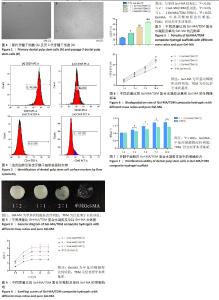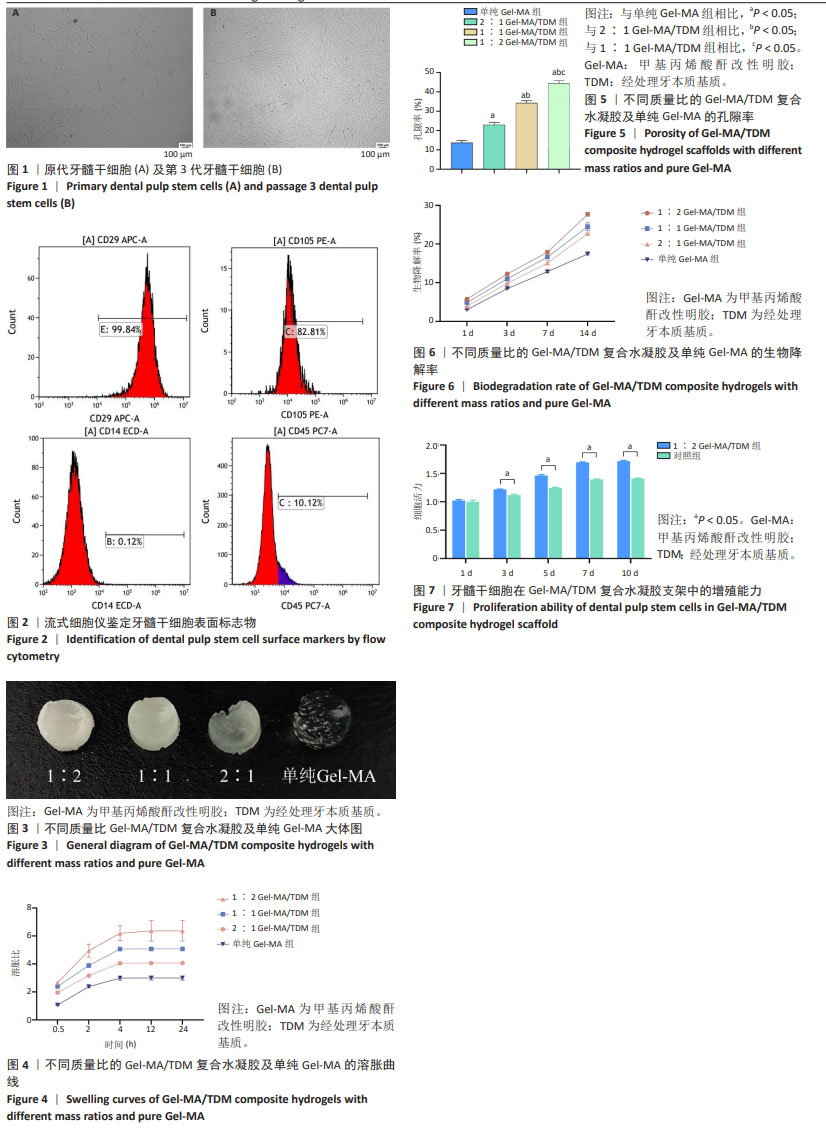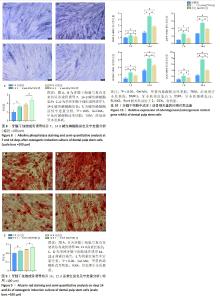Chinese Journal of Tissue Engineering Research ›› 2025, Vol. 29 ›› Issue (19): 4022-4028.doi: 10.12307/2025.071
Previous Articles Next Articles
Osteogenic/odontogenic differentiation ability of human dental pulp stem cells under photocrosslinked composite hydrogel scaffold
Yang Dujuan1, Cheng Mengke1, Liu Jia1, 2
- 1Department of Pediatric Dentistry-Preventive Stomatology, First Affiliated Hospital (Affiliated Stomatological Hospital) of Xinjiang Medical University, Urumqi 830054, Xinjiang Uygur Autonomous Region, China; 2Institute of Stomatology of Xinjiang Uygur Autonomous Region, Urumqi 830054, Xinjiang Uygur Autonomous Region, China
-
Received:2024-02-20Accepted:2024-04-27Online:2025-07-08Published:2024-09-12 -
Contact:Liu Jia, MD, Associate professor, Associate chief physician, Master’s supervisor, Department of Pediatric Dentistry-Preventive Stomatology, First Affiliated Hospital (Affiliated Stomatological Hospital) of Xinjiang Medical University, Urumqi 830054, Xinjiang Uygur Autonomous Region, China; Institute of Stomatology of Xinjiang Uygur Autonomous Region, Urumqi 830054, Xinjiang Uygur Autonomous Region, China -
About author:Yang Dujuan, Master candidate, Department of Pediatric Dentistry-Preventive Stomatology, First Affiliated Hospital (Affiliated Stomatological Hospital) of Xinjiang Medical University, Urumqi 830054, Xinjiang Uygur Autonomous Region, China -
Supported by:Graduate Practice Innovation Project of Xinjiang Uygur Autonomous Region, No. XJ2023G176 (to CMK)
CLC Number:
Cite this article
Yang Dujuan, Cheng Mengke, Liu Jia. Osteogenic/odontogenic differentiation ability of human dental pulp stem cells under photocrosslinked composite hydrogel scaffold[J]. Chinese Journal of Tissue Engineering Research, 2025, 29(19): 4022-4028.
share this article
Add to citation manager EndNote|Reference Manager|ProCite|BibTeX|RefWorks

2.1 人牙髓干细胞的培养及鉴定结果 培养第 7 天可见有 部分牙髓干细胞贴壁,见图 1A。细胞传代后 24 h 镜下可 见大部分细胞贴壁完成,细胞呈长梭形,形态似成纤维细 胞。传代至第 3 代可见细胞生长良好,形态均匀,见图 1B。流式细胞技术鉴定结果显示,细胞表面标记物 CD29 和 CD105 的阳性率为 99.84% 和 82.81%,CD14 和 CD45 的 表达为阴性,见图 2。 2.2 Gel-MA/TDM 复合水凝胶的溶胀性能 不同质量比的 Gel-MA/TDM 复合水凝胶大体观如图 3 所示,1 ∶ 2 Gel-MA/ TDM 复合水凝胶呈微黄色圆柱形的凝胶状,Gel-MA 浓度 越高,复合水凝胶的颜色越透明。单纯 Gel-MA 水凝胶 为透明的圆柱形凝胶状。不同质量比的复合水凝胶及单 纯 Gel-MA 水凝胶的溶胀曲线如图 4 所示,1 ∶ 2 质量比 的 Gel-MA/TDM 复合水凝胶溶胀比最高,在 4 h 左右达到 溶胀平衡,4 h 溶胀比为 (629.36±83.27)%。在初始 4 h 内 可见水凝胶迅速吸收溶胀 (0.5,2,4 h 溶胀比明显增高, P < 0.05),然后溶胀速度开始减慢,直至溶胀平衡 (12, 24 h 溶胀比未见明显变化,P > 0.05)。 2.3 Gel-MA/TDM 复合水凝胶的孔隙率及生物降解率 孔 隙率检测结果如图 5 所示,4 组水凝胶的孔隙率差异有显 著性意义 (P < 0.05)。其中 1 ∶ 2 Gel-MA/TDM 复合水凝 胶支架的孔隙率最高,为 (44.43±1.42)%,其次是 1 ∶ 1 Gel-MA/TDM 复合水凝胶支架和 2 ∶ 1 Gel-MA/TDM 复合水 凝胶支架,分别为 (34.41±1.07)% 和 (23.04±1.27)%,单纯 Gel-MA 组的孔隙率最低,为 (13.77±1.07)%。生物降解率如 图 6 所示,4 组支架的生物降解率差异有显著性意义 (P < 0.05)。在第 14 天时,1 ∶ 2 Gel-MA/TDM 复合水凝胶支 架的生物降解率最高,达到了 25% 以上,为 (27.71±0.51)%。 2.4 细胞活力 CCK-8 细胞增殖实验显示:牙髓干细胞在 1 ∶ 2 质量比 Gel-MA/TDM 复合水凝胶支架中,第 3,5, 7 天可见明显增殖 (P < 0.05),第 10 天可见增殖速度减缓, 第 7 天与第 10 天增殖无明显差异 (P > 0.05),见图 7。与 对照组相比,在第 1 天未见明显差异 (P > 0.05),第 3,5, 7,10 天时可见在复合水凝胶支架中的牙髓干细胞增殖能 力明显增强。 2.5 碱性磷酸酶染色和茜素红染色结果 牙髓干细胞在 成骨诱导液中连续培养 7,14 d 进行碱性磷酸酶染色,结 果显示 14 d 染色强度明显高于 7 d(P < 0.05),且在 1 ∶ 2 质量比 Gel-MA/TDM 复合水凝胶支架中碱性磷酸酶活性 更 高 (P < 0.05), 见 图 8。 连 续 成 骨 诱 导 14,21 d 后 进 行茜素红染色,结果显示 21 d 染色强度明显强于 14 d (P < 0.05),与对照组相比,1 ∶ 2 质量比 Gel-MA/TDM 复合 水凝胶支架内可见更明显的矿化结节生成(P < 0.05),见图9。 2.6 RT-PCR 检测 成骨诱导 14 d 的成骨 / 成牙本质相关 基因表达量明显高于 7 d(P < 0.05)。1 ∶ 2 质量比 Gel-MA/ TDM 复合水凝胶支架中的成骨 / 成牙本质相关基因表达高 于对照组及单纯 Gel-MA 组,单纯 Gel-MA 组中成骨 / 成牙 本质相关基因表达高于对照组 ( 均 P < 0.05),见图 10。"

| [1] CUI D, LI H, WAN M, et al. The Origin and Identification of Mesenchymal Stem Cells in Teeth: from Odontogenic to Non-odontogenic. Curr Stem Cell Res Ther. 2018;13(1):39-45. [2] SCHMALZ G, WIDBILLER M, GALLER KM. Clinical Perspectives of Pulp Regeneration. J Endod. 2020;46(9S):S161-S174. [3] KıLıÇ Y, KARATAŞLıOĞLU E, KAVAL ME. The Effect of Root Canal Preparation Size and Taper of Middle Mesial Canals on Fracture Resistance of the Mandibular Molar Teeth: An In Vitro Study. J Endod. 2021;47(9):1467-1471. [4] SISMANOGLU S, ERCAL P. Dentin-Pulp Tissue Regeneration Approaches in Dentistry: An Overview and Current Trends. Adv Exp Med Biol. 2020;1298: 79-103. [5] SUGIAMAN VK, DJUANDA R, PRANATA N, et al. Tissue Engineering with Stem Cell from Human Exfoliated Deciduous Teeth (SHED) and Collagen Matrix, Regulated by Growth Factor in Regenerating the Dental Pulp. Polymers (Basel). 2022;14(18):3712. [6] YUAN SM, YANG XT, ZHANG SY, et al. Therapeutic potential of dental pulp stem cells and their derivatives: Insights from basic research toward clinical applications. World J Stem Cells. 2022;14(7):435-452. [7] YOSHIDA S, TOMOKIYO A, HASEGAWA D, et al. Insight into the Role of Dental Pulp Stem Cells in Regenerative Therapy. Biology (Basel). 2020;9(7):160. [8] 张浩,高淑君,武沐洋,等.低氧浓度促进人牙髓干细胞增殖及神经分化[J].中国组织化学与细胞化学杂志,2022,31(2):133-138. [9] XIE Z, SHEN Z, ZHAN P, et al. Functional Dental Pulp Regeneration: Basic Research and Clinical Translation. Int J Mol Sci. 2021;22(16):8991. [10] LIU P, ZHANG Y, MA Y, et al. Application of dental pulp stem cells in oral maxillofacial tissue engineering. Int J Med Sci. 2022;19(2):310-320. [11] FERNANDES TL, CORTEZ DE SANTANNA JP, FRISENE I, et al. Systematic Review of Human Dental Pulp Stem Cells for Cartilage Regeneration. Tissue Eng Part B Rev. 2020;26(1):1-12. [12] DAS M, SLOAN AJ. Stem cell sources from human biological waste material: a role for the umbilical cord and dental pulp stem cells for regenerative medicine. Hum Cell. 2023;36(4):1312-1325. [13] 赵阳鹏,陈佳楠,朱强.组织工程技术在牙髓再生中的研究进展[J].临床口腔医学杂志,2023,39(10):634-637. [14] CHANSORIA P, ASIF S, POLKOFF K, et al. Characterizing the Effects of Synergistic Thermal and Photo-Cross-Linking during Biofabrication on the Structural and Functional Properties of Gelatin Methacryloyl (GelMA) Hydrogels. ACS Biomater Sci Eng. 2021;7(11):5175-5188. [15] SUN M, SUN X, WANG Z, et al. Synthesis and Properties of Gelatin Methacryloyl (GelMA) Hydrogels and Their Recent Applications in Load-Bearing Tissue. Polymers (Basel). 2018;10(11):1290. [16] PEPELANOVA I, KRUPPA K, SCHEPER T, et al. Gelatin-Methacryloyl (GelMA) Hydrogels with Defined Degree of Functionalization as a Versatile Toolkit for 3D Cell Culture and Extrusion Bioprinting. Bioengineering (Basel). 2018;5(3):55. [17] ZHANG X, ZHOU S, ZHAN Y, et al. Molecular insights into the proteomic composition of porcine treated dentin matrix. Mater Today Bio. 2024;25: 100990. [18] LI R, GUO W, YANG B, et al. Human treated dentin matrix as a natural scaffold for complete human dentin tissue regeneration. Biomaterials. 2011; 32(20):4525-4538. [19] ZHU T, GUO WH. Dentin matrix in tissue regeneration: a progress report. Hua Xi Kou Qiang Yi Xue Za Zhi. 2019;37(1):92-96. [20] BI F, ZHANG Z, GUO W. Treated Dentin Matrix in Tissue Regeneration: Recent Advances. Pharmaceutics. 2022;15(1):91. [21] YANG B, CHEN G, LI J, et al. Tooth root regeneration using dental follicle cell sheets in combination with a dentin matrix - based scaffold. Biomaterials. 2012;33(8):2449-2461. [22] 程梦可,杨杜娟,刘佳.甲基丙烯酸酐改性明胶/经处理牙本质基质生物活性支架的制备及性能[J].中国组织工程研究,2024,28(22): 3555-3560. [23] 刘源,惠以宁,姜冰,等.LED红光上调MAPK信号促进炎性环境中人牙髓干细胞成骨/成牙本质分化[J].口腔疾病防治,2023,31(10):701-711. [24] MOUSSA DG, APARICIO C. Present and future of tissue engineering scaffolds for dentin-pulp complex regeneration. J Tissue Eng Regen Med. 2019;13(1):58-75. [25] 黄波,陈明学,彭礼庆,等.可注射性甲基丙烯酸酐改性明胶/软骨源性基质微粒复合水凝胶支架的制备及生物相容性[J].中国组织工程研究,2022,26(16):2480-2486. [26] KLOTZ BJ, GAWLITTA D, ROSENBERG AJWP, et al. Gelatin-Methacryloyl Hydrogels: Towards Biofabrication-Based Tissue Repair. Trends Biotechnol. 2016;34(5):394-407. [27] DUBEY N, RIBEIRO JS, ZHANG Z, et al. Gelatin methacryloyl hydrogel as an injectable scaffold with multi-therapeutic effects to promote antimicrobial disinfection and angiogenesis for regenerative endodontics. J Mater Chem B. 2023;11(17):3823-3835. [28] CELIKKIN N, MASTROGIACOMO S, JAROSZEWICZ J, et al. Gelatin methacrylate scaffold for bone tissue engineering: The influence of polymer concentration. J Biomed Mater Res A. 2018;106(1):201-209. [29] KHAYAT A, MONTEIRO N, SMITH EE, et al. GelMA-Encapsulated hDPSCs and HUVECs for Dental Pulp Regeneration. J Dent Res. 2017;96(2):192-199. [30] HOLIEL AA, MUSTAFA HM, SEDEK EM. Biodegradation of an injectable treated dentin matrix hydrogel as a novel pulp capping agent for dentin regeneration. BMC Oral Health. 2023;23(1):126. [31] GRAWISH ME, GRAWISH LM, GRAWISH HM, et al. Demineralized Dentin Matrix for Dental and Alveolar Bone Tissues Regeneration: An Innovative Scope Review. Tissue Eng Regen Med. 2022;19(4):687-701. [32] TRAPHAGEN SB, FOURLIGAS N, XYLAS JF, et al. Characterization of natural, decellularized and reseeded porcine tooth bud matrices. Biomaterials. 2012;33(21):5287-5296. [33] JIAO L, XIE L, YANG B, et al. Cryopreserved dentin matrix as a scaffold material for dentin-pulp tissue regeneration. Biomaterials. 2014;35(18): 4929-4939. [34] LIU S, SUN J, YUAN S, et al. Treated dentin matrix induces odontogenic differentiation of dental pulp stem cells via regulation of Wnt/β-catenin signaling. Bioact Mater. 2021;7:85-97. [35] 李鹏,杨秀.基于铜离子交联改善壳聚糖水凝胶力学性能和抗菌性能的研究[J].北京生物医学工程,2024,43(1):88-93. [36] FATHIL MAM, KATAS H. Antibacterial, Anti-Biofilm and Pro-Migratory Effects of Double Layered Hydrogels Packaged with Lactoferrin-DsiRNA-Silver Nanoparticles for Chronic Wound Therapy. Pharmaceutics. 2023;15(3):991. [37] LI L, YU F, ZHENG L, et al. Natural hydrogels for cartilage regeneration: Modification, preparation and application. J Orthop Translat. 2018;17:26-41. [38] ZHOU Z, CUI J, WU S, et al. Silk fibroin-based biomaterials for cartilage/osteochondral repair. Theranostics. 2022;12(11):5103-5124. [39] SEDEK EM, KAMOUN EA, EL-DEEB NM, et al. Photocrosslinkable gelatin-treated dentin matrix hydrogel as a novel pulp capping agent for dentin regeneration: I. synthesis, characterizations and grafting optimization. BMC Oral Health. 2023;23(1):536. [40] LIU Y, LI T, SUN M, et al. ZIF-8 modified multifunctional injectable photopolymerizable GelMA hydrogel for the treatment of periodontitis. Acta Biomater. 2022;146:37-48. |
| [1] | Sun Yuting, Wu Jiayuan, Zhang Jian. Physical factors and action mechanisms affecting osteogenic/odontogenic differentiation of dental pulp stem cells [J]. Chinese Journal of Tissue Engineering Research, 2025, 29(7): 1531-1540. |
| [2] | Zhao Zengbo, Li Chenxi, Dou Chenlei, Ma Na, Zhou Guanjun. Anti-inflammatory and osteogenic effects of chitosan/sodium glycerophosphate/sodium alginate/leonurine hydrogel [J]. Chinese Journal of Tissue Engineering Research, 2025, 29(4): 678-685. |
| [3] | Yu Shuangqi, Ding Fan, Wan Song, Chen Wei, Zhang Xuejun, Chen Dong, Li Qiang, Lin Zuoli. Effects of polylactic acid-glycolic acid copolymer/lysine-grafted graphene oxide nanoparticle composite scaffolds on osteogenic differentiation of MC3T3 cells [J]. Chinese Journal of Tissue Engineering Research, 2025, 29(4): 707-712. |
| [4] |
Li Yunzhe, Niu Zefan, Wang Zirou, Ai Chongyi, Chen Gang, Wang Xinxing.
Asperosaponin VI promotes osteogenic differentiation of MC3T3-E1 cells under hypoxia environment #br#
#br#
[J]. Chinese Journal of Tissue Engineering Research, 2025, 29(35): 7481-7489.
|
| [5] | Liu Haowen, Qiao Weiping, Meng Zhicheng, Li Kaijie, Han Xuan, Shi Pengbo. Regulation of osteogenic effects by bone morphogenetic protein/Wnt signaling pathway: revealing molecular mechanisms of bone formation and remodeling [J]. Chinese Journal of Tissue Engineering Research, 2025, 29(3): 563-571. |
| [6] | Zeng Yu, Xie Chengwei, Hong Yuanqi, Su Shenghui, Dong Xieping. In vitro angiogenesis and osteogenesis properties of copper-doped mesoporous bioactive glass [J]. Chinese Journal of Tissue Engineering Research, 2025, 29(28): 5941-5949. |
| [7] | Shi Chunrong, He Jiaxu, Deng Lishan, Wang Hailan, Zhao Aimin, Yu Yiling, Geng Haixia, Song Weijun. Application of graphene oxide in field of oral implant restoration [J]. Chinese Journal of Tissue Engineering Research, 2025, 29(28): 6118-6126. |
| [8] | Li Zeming, Zhang Yuntao, Wang Maolin, Hou Yudong. Role and mechanism of hypoxia-inducible factor 1 alpha regulating bone homeostasis in oral and maxillofacial diseases [J]. Chinese Journal of Tissue Engineering Research, 2025, 29(26): 5680-5687. |
| [9] | Ma Yue, Tan Shiyu, Chu Feiyang, Chen Zhuoqi, Liu Siyu, Liu Wenshuai, Liu Xia. Chondrocyte proliferation and tissue formation enhanced by stromal cell derived factor-1 modified poly-L-lactic acid porous microspheres [J]. Chinese Journal of Tissue Engineering Research, 2025, 29(22): 4653-4662. |
| [10] | Yang Yuqian, Li Wenjun, Zhao Jian, Chen Gang. Injectable dental pulp extracellular matrix prepared by grinding treatment for dental pulp regeneration [J]. Chinese Journal of Tissue Engineering Research, 2025, 29(22): 4663-4670. |
| [11] | Cheng Xinqi, Shao Longhui, Shen Huaqiao, Liu Hongwei. Osteogenic and antibacterial effects of titanium alloy modified with copper-strontium binary doped calcium silicate coating [J]. Chinese Journal of Tissue Engineering Research, 2025, 29(22): 4639-4646. |
| [12] | Zheng Li, Ding Yiheng, Li Xinhao, Wen Zekai, Jiang Bingzheng, Lin Xuexia. Role of neuropilin 1 in promoting angiogenesis-osteogenesis coupling during fracture healing [J]. Chinese Journal of Tissue Engineering Research, 2025, 29(21): 4576-4583. |
| [13] | Liu Zhaohui, Han Xiaoqian, Duan Xin, Guo Pengda, Zhang Yuntao. Salidroside promotes osteogenic differentiation of MC3T3-E1 cells: an in vitro experiment [J]. Chinese Journal of Tissue Engineering Research, 2025, 29(2): 231-237. |
| [14] | Luo Jing, Yong Min, Chen Qi, Yang Changyi, Zhao Tian, Ma Jing, Mei Donglan, Hu Jinpeng, Yang Zhaojun, Wang Yuran, Liu Bo. Effect of oxymatrine on expression of stem markers and osteogenic differentiation of periodontal ligament stem cells [J]. Chinese Journal of Tissue Engineering Research, 2025, 29(19): 3992-3999. |
| [15] | Zhang Jiahao, Li Jiacheng, Wen Mingtao, Guo Yanbo, Luo Di, Li Gang. Astragaloside IV alleviates oxidative stress injury and promotes osteogenesis in MC3T3-E1 cells [J]. Chinese Journal of Tissue Engineering Research, 2025, 29(17): 3529-3536. |
| Viewed | ||||||
|
Full text |
|
|||||
|
Abstract |
|
|||||

